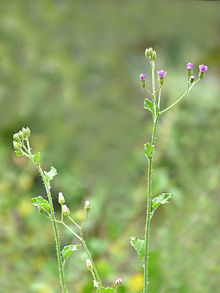Cyanthillium cinereum
| Cyanthillium cinereum | |
|---|---|

| |
| in Kadavoor, Kerala, India | |
| Scientific classification | |
| Kingdom: | |
| (unranked): | |
| (unranked): | |
| (unranked): | |
| Order: | |
| Family: | |
| Genus: | |
| Species: | C. cinereum
|
| Binomial name | |
| Cyanthillium cinereum | |
| Synonyms[1] | |
|
Synonymy
| |

Cyanthillium cinereum (also known as little ironweed and poovamkurunnila in Malayalam) is a species of perennial plants in the sunflower family. The species is native to tropical Africa and to tropical Asia (India, Indochina, Indonesia, etc.) and has become naturalized in Australia, Mesoamerica, tropical South America, the West Indies, and the US State of Florida.[2][3][4][5][6][7][8]
Cyanthillium cinereum is an annual herb up to 120 cm (4 feet) tall. It produces flat-topped arrays of numerous flower heads, each with pinkish or purplish disc florets but no ray florets.[8] The species can be confused with Emilia sonchifolia, but the flower bracts of the latter are much longer and vase-shaped.[citation needed]
Cyanthillium cinereum has been used for smoking cessation in Thailand and other countries, and as relief for the common cold.[9]
References
- ^ The Plant List, Cyanthillium cinereum (L.) H.Rob.
- ^ "Open Source for Weed Assessment in Lowland Paddy Fields".
- ^ "Cyanthillium cinereum (L.) H.Rob". Australian Plant Name Index (APNI), IBIS database. Centre for Plant Biodiversity Research, Australian Government. Retrieved 1 July 2014.
- ^ Atlas of Living Australia
- ^ Funk, V. A., P. E. Berry, S. Alexander, T. H. Hollowell & C. L. Kelloff. 2007. Checklist of the Plants of the Guiana Shield (Venezuela: Amazonas, Bolivar, Delta Amacuro; Guyana, Surinam, French Guiana). Contributions from the United States National Herbarium 55: 1–584
- ^ Carnevali, G., J. L. Tapia-Muñoz, R. Duno de Stefano & I. M. Ramírez Morillo. 2010. Flora Ilustrada de la Peninsula Yucatán: Listado Florístico 1–326
- ^ García-Mendoza, A. J. & J. A. Meave. 2011. Diversidad Florística de Oaxaca: de Musgos a Angispermas 1–351. Universidad Nacional Autónoma de México, Ciudad Universitaria
- ^ a b Flora of North America, Cyanthillium cinereum (Linnaeus) H. Robinson
- ^ Wongwiwatthananukit, Supakit (January 2009). "Efficacy of Vernonia cinerea for smoking cessation" (PDF). Journal of Health Research. 23 (1). Bangkok, Thailand: College of Public Health Sciences, Chulalongkorn University: 31–6.
External links
